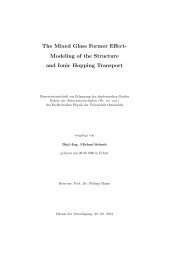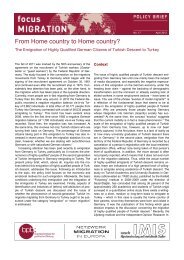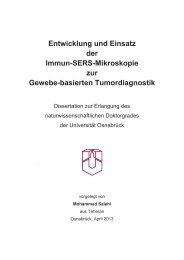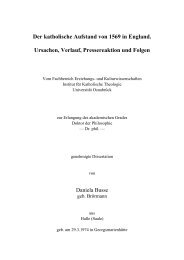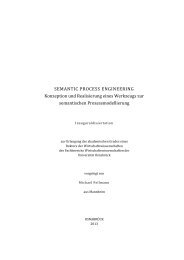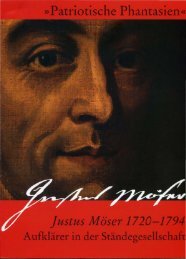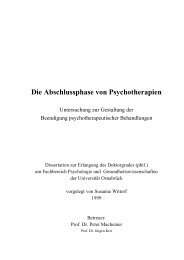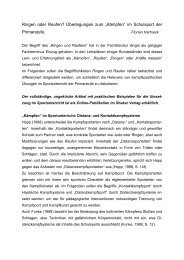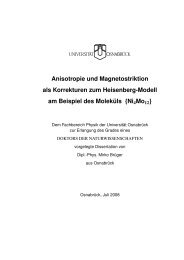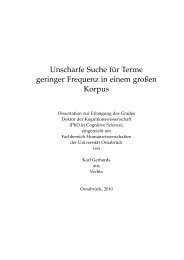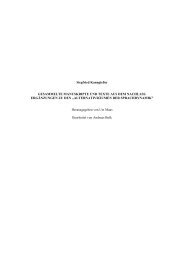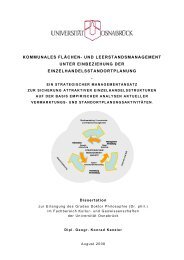'STAMENOID PETALS' IN A NATURAL HOMEOTIC VARIANT OF
'STAMENOID PETALS' IN A NATURAL HOMEOTIC VARIANT OF
'STAMENOID PETALS' IN A NATURAL HOMEOTIC VARIANT OF
Create successful ePaper yourself
Turn your PDF publications into a flip-book with our unique Google optimized e-Paper software.
Chapter 1 Repeated evolution of a floral trait in Capsella<br />
In Gau-Odernheim, wild-type shepherd's purse is one of the predominant species in<br />
vineyards with at least tens of thousands of individuals. The abundance of the decandric<br />
variant is approximately 10% of the total population size compared with the occurrence of<br />
wild-type plants. A second population of the decandric C. bursa-pastoris is located in<br />
Warburg (Westphalia, Germany). In contrast to Gau-Odernheim, this population is of low<br />
individual number due to the limited extension on basalt subsoil on the hilltop of the<br />
'Desenberg'. The occurrence of less than 20 decandric C. bursa-pastoris is entirely<br />
restricted to the hilltop within an area of 200m², whereas the wild-type occurs more<br />
frequently, and is also observed on hillsides and at lower parts of the 'Desenberg'. Only<br />
single individuals were available for three additional provenances. These are ruderal<br />
populations in Petrozavodsk (Russia), in Haugsdorf and Vienna-Hütteldorf (both in Lower<br />
Austria).<br />
Seed collection and sampled individuals<br />
In May 2005 seeds of both floral variants of C. bursa-pastoris were collected in vineyards<br />
close to Gau-Odernheim. Due to the broad habitat range, the population was divided into<br />
15 sub-sites (Pop.-No 1949-1964). Seed collection in the Warburg population (Pop.-No.<br />
1965) was done in June 2005 and 2006. During a field trip in July 1997 seeds from 15<br />
C. bursa-pastoris plants were collected on a train platform in Petrozavodsk (Russia). In<br />
subsequent analysis, the progeny revealed one decandric individual (1528/2) while a<br />
second one showed an intermediate floral phenotype (1528/5). On a field trip to Lower<br />
Austria in August 2005, two additional locations were discovered. A single individual was<br />
recorded in Haugsdorf (Lower Austria, Pop.-No.1966; H Hurka pers. communication) and<br />
two further individuals with decandric morphology were collected in Vienna-<br />
Hütteldorf (Austria, Pop.-No. 1967).<br />
Offspring from field collections were cultivated in a greenhouse under controlled<br />
conditions (12h illumination / day: min 14°C - max 30°C; night: min 10°C). In total, 34<br />
decandric individuals were applied for the analyses (Table 1). In addition to decandric<br />
individuals, 29 wild-type samples were included (63 samples in total). Due to the large<br />
Gau-Odernheim population, only a subset of individuals (23 decandric / 21 wild-type<br />
plants) was chosen by chance for the present study. Two progenies of a single decandric<br />
individual from Russia were considered. Among three decandric samples from Lower<br />
Austria, one individual (1966/1; Haugsdorf) was excluded from all further analyses since<br />
the petals were apparently not transformed but completely lacking.<br />
20



